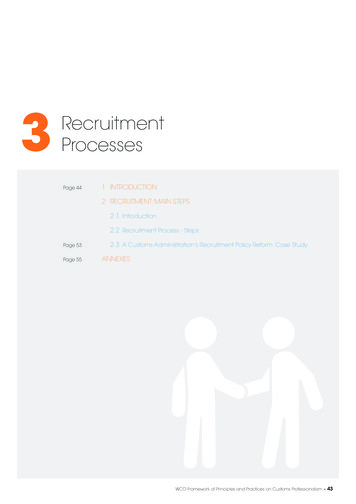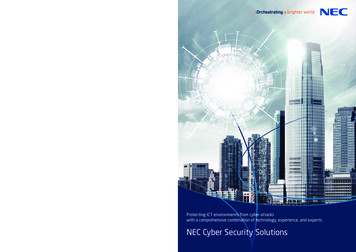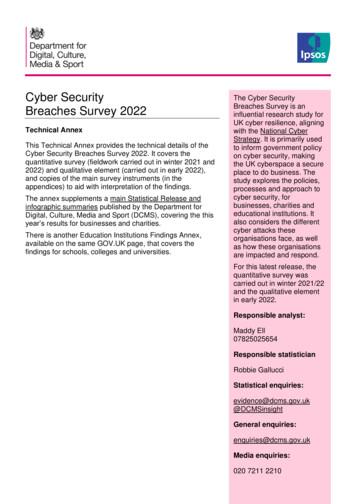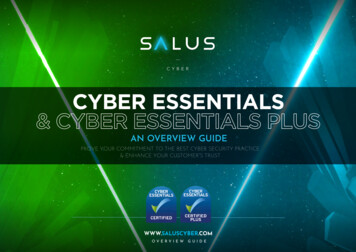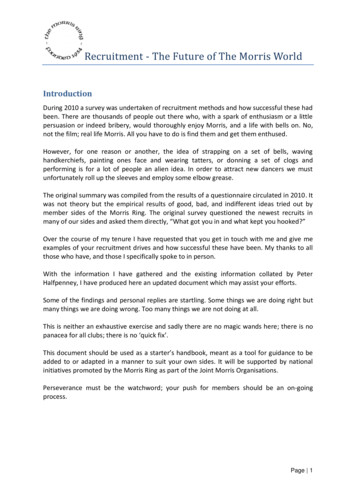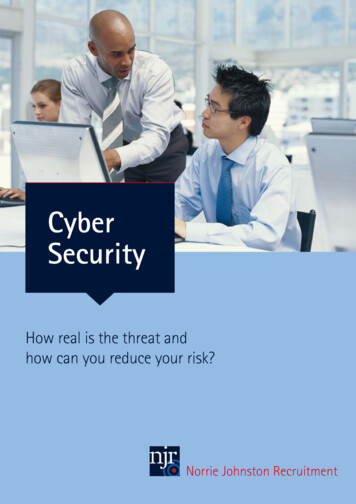
Transcription
CyberSecurityHow real is the threat andhow can you reduce your risk?Norrie Johnston Recruitment
IntroductionCyber security is a hot topic for us all, whether we’re in the business world, the IT world orthe employment world. Everywhere you look, data and forecasts demonstrate the scale of theproblem and news of major corporations being hit by hackers regularly hits the headlines.One study by the Center for Strategic and International Studies, a Washington DC policyresearch group, and McAfee, the technology security firm, puts the annual cost ofcybercrime to the world economy at more than 400bn to say nothing of the wider impacton business reputations and personal lives. Gartner estimates that there are over 500,000cyber attacks globally every day and that cyber spending will hit 86bn this year.As a result, businesses are fast waking up to the need to protect their cyber presence.Cisco estimates that there will be 1 million cyber security job openings in 2016. Demand isexpected to rise to 6 million globally by 2019, with a projected shortfall of 1.5 million, saysMichael Brown, CEO at Symantec, the world’s largest security software vendor. All of whichmeans that cyber experts are in huge demand in the employment marketplace. IT JobsWatchreports that the average salary for a cyber expert in the UK in the first quarter of 2016 was 60,000 – close to a fifteen per cent increase in one year and Burning Glass, in its report oncyber security and the Job Market, says that cyber experts can command an average salarynine per cent higher than other IT professionals.And this is not a temporary phenomenon. All the research shows that technology trends,such as mobile applications, the proliferation of open wireless networks and the Internet ofEverything will continue to extend the scale and reach of cybercrime. At Norrie JohnstonRecruitment (NJR), we have carried out our own research on how individuals react tocommon cyber security threats and what this means for them as consumers, employees andemployers. The results merely underline the scale of the problem at the simplest level, as youcan see on the following page. In addition, we’ve commissioned a series of experts in cybersecurity to delve into these issues in more detail and provide guidance on how companiesand individuals can prevent and manage these threats – we hope you’ll enjoy reading theirthoughts and advice.There are clearly major implications in all this for the employment world. The competitionfor talent, to secure the best qualified and most experienced resources will be intense andcompanies need to work closely with committed and focused search firms, such as NJR, toensure they have the best chance of fulfilling their hiring needs.But there is also a wider lesson that is underlined time and again in our report: thatcyber security is not the preserve of a small number of experts within a company. It isthe responsibility of everybody. It needs close integration between IT, HR and Security; itneeds to be embedded in the culture of the organisation and it needs to be built into theentire employment lifecycle starting with pre-employment screening and on-boarding andinduction processes.Graham OatesChief Executive, Norrie Johnston Recruitment.norriejohnstonrecruitment.comNorrie Johnston Recruitment Page 2
How real is the threat?As our contributors will go on to tell us, one of thegreatest risks to a company’s cyber security is, in fact,its employees.More worryingly, the way employees behave could beexposing companies to higher levels of risk. A lack ofawareness about, or a lax attitude towards, cyber securitygood practice means we are regularly putting our employers’security at risk. For example, Norrie Johnston Recruitment’sresearch showed that 40 per cent of respondents use thesame password for different applications or write down theirpasswords, 16 per cent work while connected to public wifinetworks and 15 per cent access social media sites on theirwork PCs. All of which potentially leave a company’s cyberdoors wide open.Simply by being IT users and consumers, the majority ofus are regularly exposed to cyber scams, often throughno fault of our own. According to research carried out onbehalf of Norrie Johnston Recruitment, just over 50 percent of respondents had experienced some kind of scamin the last twelve months from a fake email from Paypal,Apple or a bank (29 per cent) to a Facebook scam (12 percent) to clicking a link that put a virus on a PC (7 per cent).It’s clear to see this problem is very real.But by following the advice set out in this guide, you canensure your company takes a smarter approach to cybersecurity, reducing your risk of attack.Question One: Which of the following have you experienced in the past 12 months?*17%A scam email purporting to be from a friend12%A scam on Facebook7%Clicking a link putting a virus on your PC29%A fake email from PayPal, Apple or your bankSomeone using your credit card details3%16%Someone calling about a problem with your PCQuestion two: Which of the following have you done?**7%Used someone else’s USB stick on my work PC16%Used public wifi for workWritten down my passwords17%Downloaded apps to a work phone5%Opened attachments from unknown senders5%Transferred work documents via unsecure apps2%23%Used the same password for different appsLet someone use my work computerLooked at social media sites on my work PC10%15%* figures based on 1505 survey responses** figures based on 1512 survey responsesnorriejohnstonrecruitment.comNorrie Johnston Recruitment Page 3
ContentsThe scale of the problem8Reducing the risk to your company11Managing a cyber breach18How different sectors are affected22How to protect ourselves from cyber scams30norriejohnstonrecruitment.comNorrie Johnston Recruitment Page 4
ContributorsBarry Scott, CentrifyBarry is EMEA Chief Technology Officer at Centrify. He is focused on bringing the benefitsof Centrify’s unified identity management software and cloud-based Identity as a Service(IDaaS) solutions into easier reach of businesses by helping customers leverage theirexisting identity infrastructure.Prior to his appointment as CTO, Barry held the post of technical director at Centrify for nineyears. In this role, he helped organisations manage their Identity Management and Auditing.Benny Czarny, OPSWATBenny is the Founder and CEO of OPSWAT and has over 20 years’ experience in theComputer and Network Security field. From the early days of computer viruses, he hasbeen interested and involved in the fields of encryption, network operations, securityvulnerabilities detection and research.He worked as a programmer, team leader and engineering manager in several companiesbefore founding OPSWAT in 2002.Eldar Tuvey, WanderaEldar is Co-Founder and CEO of Wandera, the provider of advanced mobile threat preventionfor enterprises. He is responsible for driving the company’s strategic direction and growth.Prior to co-founding Wandera, Eldar co-founded and served as CEO of ScanSafe. Eldarstarted his career at Goldman Sachs and completed his MBA at INSEAD.François Amigorena, IS DecisionsFrançois is the founder and CEO of IS Decisions, a provider of infrastructure and securitymanagement software solutions for Microsoft Windows and Active Directory. IS Decisionsoffers solutions for user-access control, file auditing, server and desktop reporting, andremote installations.Its customers include the FBI, the United Nations and Barclays who rely on IS Decisions toprevent security breaches; ensure compliance with major regulations; such as SOX, FISMA andHIPAA; quickly respond to IT emergencies; and save time and money for the IT department.Gary Peace, ESID ConsultingGary is a specialist in Insider Threat Management, Information Security, ProtectiveMonitoring and in Business Resilience / Continuity. He founded ESID Consulting, whichworks with governments, HNW individuals, think tanks, companies and organisations of allsizes, across a range of sectors.A former New Scotland Yard detective, Gary was responsible for ‘Insider Threat Monitoring’ andall internal and Anti-Corruption (network) Investigations across the force. He is also a formerHead of the Digital Investigations for the UK Competition and Markets Authority.norriejohnstonrecruitment.comNorrie Johnston Recruitment Page 5
Contributors (continued)Jim Steven, ExperianJim is Head of Data Breach Services for Experian in the UK where his focus is on helpingbusinesses take proactive steps to prepare for the ever-growing threat of data breach andsupporting organisations through this challenge.Prior to joining Experian, Jim worked in the security and risk management industry providingexpertise in security risk management solutions, travel risk management, aviation securityand corporate security for some of the world’s largest security companies.Paul German, Certes NetworksPaul is Certes Networks’ VP EMEA, responsible for growing the company across the region.Certes Networks’ award-winning CryptoFlow Solutions enable enterprise applicationsto be securely extended to any user on any device in any network, Cloud or virtualenvironment. Companies around the world rely on Certes to protect access, accelerateapplication deployment, simplify network projects, reduce IT costs, contain breach threats,and shrink the enterprise attack surface.Pedro Abreu, ForeScoutPedro is Chief Strategy Officer at ForeScout, the network security experts. With more thanfifteen years’ experience in the high-tech industry across Europe and North America, Pedrohas a deep understanding of all go-to-market aspects, along with knowledge of buildinghighly effective teams and developing strong relationships with clients and stakeholders.Reinhard Mayr, COPA-DATA.Reinhard is product manager at the industrial automation software expert COPA-DATAand is based at the company’s headquarters in Austria.COPA-DATA is the technological leader for ergonomic and highly dynamic processsolutions. The company, founded in 1987, develops the software zenon for HMI/SCADA,Dynamic Production Reporting and integrated PLC systems.Richard Cassidy, Alert LogicRichard is the expert product lead and technical evangelist for Alert Logic solutions inthe EMEA region. He is jointly responsible for developing and implementing the technicalstrategy for the international business in terms of team growth and channel development.He is also responsible for working directly with new and strategic partners in the Cloud(Private and Public), Service-Provider and Reseller markets.norriejohnstonrecruitment.comNorrie Johnston Recruitment Page 6
Contributors (continued)Ryan Wilk, NuData SecurityRyan is the Vice President of Customer Success at NuData Security where he is responsiblefor ensuring the success of every NuData customer during the lifetime of the partnership.In his previous role, Ryan was the Manager, Trust and Safety at StubHub, an ebaycompany. Prior to joining StubHub, Ryan spent eight years with Universal Parks & Resortswhere he established and implemented the eCommerce Loss Prevention teams at bothUniversal Orlando Resort and Universal Studios Hollywood.Sarel Lamprecht, Phishield GroupSarel is cofounder and Managing Director of the Phishield Group which offers the first loss offunds warranty that protects individuals against cyber-fraud and phishing attacks, globally.Sarel is currently studying part time for a PhD.Simon Heron, Redscan LtdSimon is CTO of Redscan Ltd and is responsible for the development of the company’sAdvanced Malware Detection platform and service.Simon has worked with market leading companies throughout his career including BellLabs, Huawei and Thomson Reuters. He has more than nineteen years’ experience in the ITsecurity industry and has developed and designed technologies including firewalls, antivirus, LANs and WANs.Tarun Samtani, Findel plcTarun is the Group Cyber Security Manager for Findel plc, Express-Gifts and FindelEducation and has fifteen years of experience working across sectors includingtelecommunications, ISPs, financial services, gambling and retail.During the course of his career Tarun has been involved in the strategy planning,architecture, design and implementation of a number of enterprise security programmes.He has a passion for Cyber Security and regularly addresses global audiences.Tony Berning, OPSWATTony joined OPSWAT in 2012 to manage the Metascan and Metadefender product lines. Hehas over ten years’ experience in software development and product management in bothAgile and Waterfall environments.His expertise includes global market analysis through Dun and Bradstreet’s GraduateLeadership Program, managing a product line with 100,000 customers drawing 50Min annual revenue and developing products to secure critical infrastructure and SCADAenvironments worldwide.norriejohnstonrecruitment.comNorrie Johnston Recruitment Page 7
The scale ofthe problemTo set the scene, Gary Peace (ESIDConsulting) introduces us to the scale ofthe cyber security problem and reveals thebiggest threat to a company – its employees.norriejohnstonrecruitment.comNorrie Johnston Recruitment Page 8
The scale of the problemCyber Security and Cyber Crime are intrinsicallylinked. The term cyber is fast becoming the buzzword, used by everybody with something to sayabout the risks and threats of doing anything online.However, the term is just adding a gloss to an alreadyexisting problem facing business and consumers.But the problem is nothing new, it is just simply oldfashioned ‘crime’, just being committed with the aid ofor over computer networks. That’s it. It’s still theft orcriminal damage or fraud.What this all points to, is a lack of a security culturein organisations, with security being seen as aninconvenience as opposed to a benefit. There is too muchfocus on technology and too much reliance on an alreadyoverstretched IT department.So what is the scale of the problem? Well it’s big andgetting bigger and it’s aided by the way we do businessand manage our lives in this internet enabled world thatwe inhabit.But the solution is simple. There needs to be more joined upthinking between HR, Security and IT to remove what can bevery fragmented reporting processes. Without clear lines ofcommunication, risks, threats and security issues will not berecognised and incidents will not be dealt with holistically.The problem is that the checks and balances that existed inthe manual, physical and hierarchical office environment of20 years ago no longer exist. Back then, if we wanted a filefrom HR or finance we had to get up from our desks andgo and find the ‘gatekeeper’ to that information, persuadethem (or not) that our request was a valid one and that wewere authorised to have access to it. And only from thatpoint onwards were the keys found, cupboards unlockedand the file handed over, under supervision.Nowadays, all we do is click into a folder from our desktopand hey presto, we get access to information that waspreviously locked away. Now, maybe our access permissionsare correctly set and all the systems are working as theyshould be. If they are, then we should only have access tothose files and folders that we are entitled to. However,if the settings are wrong or no one’s told IT what weshould or shouldn’t have, then we may well have access toinformation that we are not entitled to.What’s more worrying, however, is the fact that 35% of UKemployees would sell a company’s intellectual property forthe right price! 18% of employees would sell informationfor 1,000 and 29% would sell it for 10,000.The protections that we once had in our business with astrong perimeter and robust firewalls are no longer whatthey were. In our Internet connected world things are a littlemore porous. The human factor is the gap in our defences.The insider is the biggest threat that companies face today.35%of UK employees would sell a company’sintellectual property for the right priceThe problem is that several recent and well respectedsurveys have shown that our employees do notunderstand the value of information. Over half of employees don’t understand theconsequence of company information loss. Half of employees have access to company IP thatthey themselves deem is above their pay scale. Lack of understanding is apparent in the boardroomtoo, where the value of company information ispoorly understood. Senior managers do not see the threat.norriejohnstonrecruitment.comNorrie Johnston Recruitment Page 9
The insider threatThere is much talk in the cyber security world aboutwhat is termed the ‘insider threat’. However, tothose not in the know, the term can be misleading andmean different things to different people. So, to setthe scene, the ‘insider threat’ is simply someone whoworks within your company or who has access to yoursystems and data, together with the recognition thatthere is a risk or a threat associated with that access.The insider threat is made up of four different groups of people: The Malicious InsiderThe Flight RiskThe Unwitting InsiderThe Un-Trusted InsiderThe risk posed from a Malicious Insider is, compared tothe other groups, minimal. It’s the person who wants todo something bad with your (or your clients’) data or yourcompany assets, and the reality is that thankfully, there arerelatively few of these people around.The Flight Risk is the employee who has secured a job witha competitor or who may be wants to set up his or her ownbusiness in competition with yours, and plans to use yourdata or intellectual property in this new business venture.You need to know whatyour employees are doingwith your dataThe Unwitting Insider is the biggest risk. It’s the personwho mistakenly shares your entire client list by cc’inginstead of bcc’ing their email addresses. Or it’s theemployee who finds a USB stick in a communal area anddecides to plug it into their desktop to find out who itbelongs to and in the process inadvertently downloadsmalware to your systems, from what was a ‘planted’ device.The Un-Trusted Insider might be the IT guy who you letgo last month, but because you were being nice and youallowed him to finish out the week before restricting orterminating his access, he was able to create a backdoorinto your systems, using false credentials.So, now you know who you’re looking for, how do you dealwith the insider threat? Well, it’s about building security intothe entire employment life-cycle. It’s about pre-employmentscreening, on boarding, induction and socialisation. It’sabout having the means to recognise changes in employee’spersonal circumstances and emphasising the importance ofculture, reporting and communications.Insider threat management is about performancemanagement, supervision and staff appraisals. It’s abouthaving exit strategies and procedures in place to deal withtermination of employment (a termination checklist forexample). And it’s about the integrity of your suppliers,contractors and other third parties, and making sure that theytreat your data, or your clients’ data, the way you or perhapsmore importantly your clients would expect it to be treated.One of the biggest factors in mitigating the insider threatis by scrupulously treating all employees with fairness andtransparency and avoiding any form of ‘disgruntlement’ inthe workforce, but it’s also about having visibility of userbehaviour. You need to know what your employees aredoing with your data.You need to be able to profile user behaviour (for example,the insider threat is generally male) and map it againstthe vulnerabilities in your organisation. This visibilityalso includes knowledge of your employees well-being,through a welfare support programme combined with awhistleblowing facility.When this is all integrated within a properly structured andrecognised security and business resilience or continuityframework such as ISO27001 and ISO 22301, combined withrisk profiling, user awareness, and organisational mapping, youare then able to work out the context of that behaviour. And it iscontext that is the key to managing your insider threat.norriejohnstonrecruitment.comNorrie Johnston Recruitment Page 10
Reducing therisk to yourcompanyAs our research showed, we’re all susceptible tocyber scams and constantly – often unwittingly– leave ourselves open to attack. Here we lookat some simple tactics to help change youremployees’ behaviour and reduce your risk.norriejohnstonrecruitment.comNorrie Johnston Recruitment Page 11
A few small steps for man,a giant leap for online securityBy Richard Cassidy, Alert LogicThe online world is vast; it’s a vortex of data and agateway for hackers. But you don’t have to transforminto a Jedi to oppose the threats in the hidden fortressthat is the internet. Just encourage your employees tofollow these straightforward and simple tips to make lifeharder for hackers and keep you secure.Open Wireless Access PointsAs you take a seat on the comfy leather sofas in Starbucks,slurping on your foamy Café Latte, the next stage in theritual is to catch-up on emails, read the latest news, listento a podcast or just search the web . but STOP. Most mobiledevices now automatically connect to wireless networks butopen wireless networks are inherently insecure.You are giving hackers easy access to your contacts, pictures,data and possibly even your company data – making theexfiltration easy. Hotel networks are not exempt either. Thesaying, when in Rome, does not apply to open Wi-Fi.Apps - read the small printYou’re walking in the street and a stranger asks permissionto use your phone. You have all your information, photos,contact details etc on there and, of course, you politelydecline. So why are you agreeing to let the apps on yourphone do the same? The more access points there areto your data, the harder it is to maintain security. Readthe permissions list and tie it back to the app’s features:for example, why would a parking app need to accessyour photos, contacts, text messages and many moremisunderstood and underestimated permissions? You’reright to be suspicious.Password RecoveryAlmost everybody has a password recovery set up of somesort. Most people are conscious that simple passwords arenot secure, so they are making their passwords longer andstronger. But the knock-on effect of this is that hackerstry to find the weakest link in, and so are now looking attaking over the password recovery process. Most of theserecovery processes ask very specific questions such as:what’s your first pet’s name, mother’s maiden name etc.Hackers can easily source this information and engineer apassword reset for your account. Any password recoveryquestion should have nothing to do with your life – oranything anybody could possibly know about you. Youalways have to be one step ahead.norriejohnstonrecruitment.com“You always have to beone step aheadCommon SenseBanks rarely communicate important account informationvia email, so if you receive an email from your bank thatdoes, either logon directly to your application (withoutclicking through from the email) or call them by phoneto verify. Getting into the habit of never clicking on linkswithin an email or opening unsolicited files will save you alot of hassle.Some people even store their credit card details onshopping sites. How many of us have said ‘yes save mydetails so I can go back and order’. You have to be savvyonline - just enter your credit details manually.Consumers definitely have a role to play in their ownsecurity. If you apply these small changes, you will make ita lot harder for hackers, and remember, if you are not sure- then it’s probably not secure!Norrie Johnston Recruitment Page 12
Passwords remain a primarysource of authenticationAre passwords past their sell-by date?By Barry Scott, CentrifyAs long as it’s complex and long enough, theconcept of the password has long been viewedas a secure and adequate means of protecting data.For the security industry however, passwords are widelyviewed as not being a suitable form of protectionon their own. Whilst we continue to use them foreveryday applications, email accounts and devicelogins, alternatives should be considered.Whenever we create an online account we willundoubtedly be asked to create a password for secureaccess. Whether it be online banking, social media or anew e-mail account at work, it is a prerequisite that wegenerate a password with a minimum of 8 characters preferably longer, avoiding obvious names and sequencessuch as 123456 or ‘password’ and always using variationson capitalisation, spelling, numbers and punctuation.System Administrators and IT managers put such passwordpolicies in place to ensure access to systems is secure andthat passwords cannot be easily guessed by outsiders. Ontop of this, enforcing regular password changes is a timehonoured tradition intended to secure the password further.However, a recent report ‘Password Guidance – SimplifyingYour Approach’ from the UK Government’s NationalTechnical Authority for Information Assurance (CESG), whichmakes some valuable suggestions and recommendationson password practices, and advises organisations on howto protect their information, also has opposing ideas onpassword expiry. In contradiction to customary regularpassword updates, the report proposes that regularnorriejohnstonrecruitment.compassword changing harms, rather than improves, security,believing it places additional burden on users.The proposition of not implementing a password expirypolicy is questionable. For some, requiring people tochange them may encourage poor password choices andrecycling them across numerous sites. It can also putpressure on users who are forced to think of new ones —and then remember them.However, passwords remain a primary source ofauthentication to data and business applications for many,and as an industry we should be encouraging companiesto think about how, and why, they use passwords, and alsodirect them towards more secure methods of authentication.2015 saw a number of big brand companies incorporatemultifactor authentication (MFA), including Amazon whoquietly added support for MFA for customers using itsecommerce site. The global MFA market is predicted toreach more than 10 billion by 2017, as its appeal increasesas a means of securing sensitive information. Using multifactor authentication and implementing single sign-on(SSO) to avoid users having multiple passwords, while alsoensuring the password is adequately protected, is a positive(and necessary) step towards keeping data secure.Users have entrusted their data to a password system thatis now flawed and outdated. By educating users, we canenable them to recognise the risks and how to fix them.It’s not simply about changing a password, but altering theway in which we use and rely on them.Norrie Johnston Recruitment Page 13
Creating a security-aware mobile cultureBy Eldar Tuvey, WanderaHistorically hackers have pursued and targetedindividuals more frequently than they havetargeted businesses, as they are typically the path ofleast resistance. However the number of organisationsworldwide falling victim to social engineering cyberattacks is dramatically rising.The latest threat duping enterprises out of millions isBusiness Email Compromise (BEC). BEC attacks are carriedout by compromising or impersonating official businessemail accounts of C-suite executives, typically the CEO orCFO. The hacker imitating the executive urgently requests anemployee, often within the accounts department, to conductan unauthorised wire transaction to a specific recipient,usually to pay a fake invoice. The message and hijackedemail account appears legitimate to the individual who,without realising, places their organisation at huge risk.Pinpointing the targetA recent example of a BEC attack in action is The ScoularCompany, an employee-owned commodities trader inNorth America. In this case the fraudster pretending tobe the CEO told the Controller in a confidential email thatScoular was in the process of acquiring a Chinese company.The Controller was instructed to liaise with a lawyer atKPMG and to wire 17.2 million to an offshore account inChina, which he did not question.Within this example, the criminal behind the attackhas clearly researched the management structure andpinpointed which employee is the best target. SophisticatedBEC attackers will typically research travel schedules ofexecutives or mergers and acquisitions to reference in theiremails. These hackers are also ultimately taking advantageof employees’ willingness to be helpful, especially whenrequested to act by a C-suite executive of the company.While employees are a company’s biggest asset, they areunfortunately usually the weakest link when it comes tosecurity. For organisations today, the only way to efficientlyprotect against attacks such as this is to arm employeeswith the know-how to avoid these compromises.norriejohnstonrecruitment.comEducating employeesEducation and subsequent repeated reinforcement, is themost effective means of protecting companies against BECscams and similar attacks. There is a frightening lack ofpublic awareness around the prevalence of these scams,therefore CEOs, CIOs and CISOs should educate employeeson what an attack entails. Employees who are aware ofthe threat and are encouraged and even empowered toscrutinise emails will have the confidence to decline or atleast double check what they perceive as an illicit request.A security-aware culture is essential.Related to this is the threat of accessing public Wi-Fi hotspotson work devices. BEC attacks rely on the hacker having contextwith which to make the request seem legitimate. These includeemail addresses and formats, names, travel details, internalprocesses – all of which can be readily gleaned through manin-the-middle attacks on public Wi-Fi.Hackers are taking advantageof employees’ willingnessto be helpfulPublic Wi-Fi hotspots are not
of Centrify's unified identity management software and cloud-based Identity as a Service (IDaaS) solutions into easier reach of businesses by helping customers leverage their existing identity infrastructure. Prior to his appointment as CTO, Barry held the post of technical director at Centrify for nine years.


